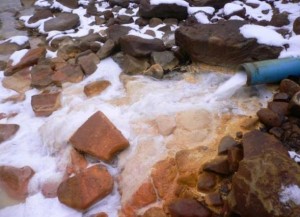Action on Climate Change is a Moral Imperative
September 30, 2013Fracking = Climate Change
October 12, 2013By smithsonian.com, October 2, 1013

New testing of treated wastewater from fracking shows that it contains high levels of radioactive radium, along with chloride and bromide
In the state of Pennsylvania, home to the lucrative Marcellus Shale formation, 74 facilities treat wastewater from the process of hydraulic fracturing (a.k.a. “fracking”) for natural gas and release it into streams. There’s no national set of standards that guides this treatment process—the EPA notes that the Clean Water Act’s guidelines were developed before fracking even existed, and that many of the processing plants “are not properly equipped to treat this type of wastewater”—and scientists have conducted relatively little assessment of the wastewater to ensure it’s safe after being treated.
Recently, a group of Duke University scientists decided to do some testing. They contacted the owners of one treatment plant, the Josephine Brine Treatment Facility on Blacklick Creek in Indiana County, Pennsylvania, but, “when we tried to work with them, it was very difficult getting ahold of the right person,” says Avner Vengosh, an Earth scientist from Duke. “Eventually, we just went and tested water right from a public area downstream.”
Their analyses, made on water samples collected repeatedly over the course of two years, were even more concerning than we’d feared. As published today in the journal Environmental Science and Technology, they found high concentrations of the element radium, a highly radioactive substance. The concentrations were roughly 200 times higher than background levels. In addition, amounts of chloride and bromide in the water were two to ten times greater than normal.
“Even if, today, you completely stopped disposal of the wastewater,” Vengosh says, there’s enough contamination built up that”you’d still end up with a place that the U.S. would consider a radioactive waste site.”
Other states require this wastewater to be pumped back down into underground deposit wells sandwiched between impermeable layers of rock, but because Pennsylvania has few of these cavities, it is the sole state that allows fracking wastewater to be processed by normal wastewater treatment plants and released into rivers.
These plants, many scientists note, are not designed to handle the radioactive elements present in the wastewater. Neither are they required to test their effluent for radioactive elements. As a result, many researchers have suspected that the barely-studied water they release into local streams retains significant levels of radioactivity.
This new work confirms that suspicion for at least one plant—which as about an hour east of Pittsburgh, and releases effluent into the watershed that supplies the city’s drinking water—and Vengosh believes that the findings would likely be similar for many of the other facilities in Pennsylvania. Especially concerning is the fact that, apart from in the water, the team found high levels of radioactivity accumulating on the sediments at the bottom of the stream over time. Radium has a half-life of 1600 years, so unless these sediments are removed, they’ll keep releasing radiation into the water for an extremely long period.
In addition, the high levels of bromide found in the wastewater is a concern, because even in slight quantities, the compound can trigger the formation of a toxic class of chemicals called halomethanes when it’s combined with chlorine. This is a problem because in rural areas, many residents treat well water by chlorinating it.
The study—which is part of a larger Duke project studying the effect of fracking on water—doesn’t show that fracking is inherently unsafe, but does show that without proper controls, the wastewater being dumped into the environment daily represents a very real danger for local residents.
Vengosh notes that there are better methods of treating fracking wastewater (he points to the plants operated by Eureka Resources as a model for adequately removing radioactivity), but these are more expensive to operate. But currently, without the push of federal regulations, companies looking to dispose of wastewater have no incentive to pay for this type of solution.



